Showing Spotlights 65 - 72 of 80 in category All (newest first):
 The catalytic conversion of chemical to mechanical energy is ubiquitous in biology, powering such important and diverse processes as cell division, skeletal muscle movement, protein synthesis, and transport of cargo within cells. Catalytic 'engines' will be key components of active micron- and sub-micron scale systems for controlled movement, particle assembly, and separations. A few days ago we took a look at catalytic nanomotors - sophisticated molecular-size biomotors have evolved in nature - and described an example where researchers supercharged their nanomotors by inserting carbon nanotubes into the gold and platinum nanowires (Speeding up catalytic nanomotors with carbon nanotubes). Today we show an example where catalytic nanomotors can, in principle, be tethered or coupled to other objects to act as the engines of nanoscale assemblies. Additionally, an object that moves by generating a continuous surface force in a fluid can, in principle, be used to pump the fluid by the same catalytic mechanism. Thus, by immobilizing these nanomotors, a group of scientists have developed micro/nanofluidic pumps that transduce energy catalytically.
The catalytic conversion of chemical to mechanical energy is ubiquitous in biology, powering such important and diverse processes as cell division, skeletal muscle movement, protein synthesis, and transport of cargo within cells. Catalytic 'engines' will be key components of active micron- and sub-micron scale systems for controlled movement, particle assembly, and separations. A few days ago we took a look at catalytic nanomotors - sophisticated molecular-size biomotors have evolved in nature - and described an example where researchers supercharged their nanomotors by inserting carbon nanotubes into the gold and platinum nanowires (Speeding up catalytic nanomotors with carbon nanotubes). Today we show an example where catalytic nanomotors can, in principle, be tethered or coupled to other objects to act as the engines of nanoscale assemblies. Additionally, an object that moves by generating a continuous surface force in a fluid can, in principle, be used to pump the fluid by the same catalytic mechanism. Thus, by immobilizing these nanomotors, a group of scientists have developed micro/nanofluidic pumps that transduce energy catalytically.
May 7th, 2008
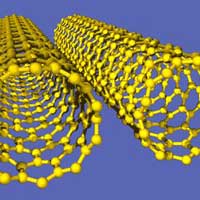 Sophisticated molecular-size motors have evolved in nature, where they are used in virtually every important biological process. In contrast, the development of synthetic nanomotors that mimic the function of these amazing natural systems and could be used in man-made nanodevices is in its infancy. Building nanoscale motors is not just an exercise in scaling down the design of a macroworld engine to nanoscale dimensions. Many factors such as friction, heat dissipation and many other mechanical behaviors are just very different at this scale - everything is constantly moving (under kinetic energy supplied by the heat of the surroundings) and being buffeted by other atoms and molecules (Brownian motion). In nature, biological motors use catalytic reactions to create forces based on chemical changes. These motors do not require external energy sources such as electric or magnetic fields. Instead, the input energy is supplied locally and chemically. Despite impressive progress over the past years, man-made nanomachines lack the efficiency and speed of their biological counterparts. New research has demonstrated that the incorporation of carbon nanotubes (CNT) into the platinum component of asymmetric metal nanowire motors leads to dramatically accelerated movement in hydrogen peroxide solutions, with average speeds of 50-60 micrometers per second.
Sophisticated molecular-size motors have evolved in nature, where they are used in virtually every important biological process. In contrast, the development of synthetic nanomotors that mimic the function of these amazing natural systems and could be used in man-made nanodevices is in its infancy. Building nanoscale motors is not just an exercise in scaling down the design of a macroworld engine to nanoscale dimensions. Many factors such as friction, heat dissipation and many other mechanical behaviors are just very different at this scale - everything is constantly moving (under kinetic energy supplied by the heat of the surroundings) and being buffeted by other atoms and molecules (Brownian motion). In nature, biological motors use catalytic reactions to create forces based on chemical changes. These motors do not require external energy sources such as electric or magnetic fields. Instead, the input energy is supplied locally and chemically. Despite impressive progress over the past years, man-made nanomachines lack the efficiency and speed of their biological counterparts. New research has demonstrated that the incorporation of carbon nanotubes (CNT) into the platinum component of asymmetric metal nanowire motors leads to dramatically accelerated movement in hydrogen peroxide solutions, with average speeds of 50-60 micrometers per second.
May 1st, 2008
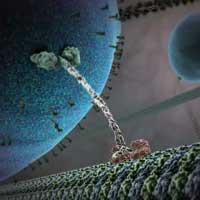 In case you haven't seen the absolutely amazing animation 'Cellular Visions: The Inner Life of a Cell' yet, go watch it now. In it, there is a sequence where a motor protein is sort of 'walking' along a filament, dragging this round sphere of lipids behind it. This kind of nanoscale biological motor is able to load/unload particular types of cargo without external stimuli, and transport them along cytoskeletal filaments by using the energy of adenosine triphosphate (ATP) hydrolysis within cells. Nanotechnology researchers are fascinated by the various molecular delivery systems that have evolved in nature and they are receiving increasing attention as blueprints for nanoscale actuators and building blocks to construct artificially-engineered bio-hybrid systems. Some researchers expect that artificial molecular transport systems which utilize microtubules motility will be an alternative way to pressure-driven or electrokinetic flow-based microfluidic devices. Researchers in Japan propose a molecular transport system that can achieve autonomous loading/unloading of specified cargoes. This system loads a cargo molecule through DNA hybridization.
In case you haven't seen the absolutely amazing animation 'Cellular Visions: The Inner Life of a Cell' yet, go watch it now. In it, there is a sequence where a motor protein is sort of 'walking' along a filament, dragging this round sphere of lipids behind it. This kind of nanoscale biological motor is able to load/unload particular types of cargo without external stimuli, and transport them along cytoskeletal filaments by using the energy of adenosine triphosphate (ATP) hydrolysis within cells. Nanotechnology researchers are fascinated by the various molecular delivery systems that have evolved in nature and they are receiving increasing attention as blueprints for nanoscale actuators and building blocks to construct artificially-engineered bio-hybrid systems. Some researchers expect that artificial molecular transport systems which utilize microtubules motility will be an alternative way to pressure-driven or electrokinetic flow-based microfluidic devices. Researchers in Japan propose a molecular transport system that can achieve autonomous loading/unloading of specified cargoes. This system loads a cargo molecule through DNA hybridization.
Apr 28th, 2008
 In our Nanowerk Spotlights we usually stay with both feet firmly on the grounds of science and shy away from the science fiction and sensationalist aspects of nanotechnology. So today's headline might come as a surprise to you (but just to be safe we put a question mark in). Of course, there are no nanobots yet, and won't be for a while, but one of the fundamental problems to be solved for possible future molecular machinery is the challenge of controlling many molecule-sized machines simultaneously to perform a desired task. Simple nanoscale motors have been realized over the past few years but these are systems that do nothing more than generate physical motion of their components at a nanoscale level. To build a true nanorobot - a completely self-contained electronic, electric, or mechanical device to do such activities as manufacturing at the nanoscale - many breakthrough advances will need to be achieved. One of them is the issue of controlling large numbers of devices, i.e. how to build and program the 'brains' of these machines. Another issue is to separate the concept of science fiction style 'thinking' robots (artificial intelligence) from a more realistic (yet still distant) concept of machines that can be programmed to perform a limited task in a more or less autonomous way for a period of time. These tasks could range from fabricating nanoscale components to performing medical procedures inside the body. For nanoscale machinery this would require the availability of nanoscale control units, i.e. computers. Researchers in Japan are now reporting a self organizing 16-bit parallel processing molecular assembly that brings us a step closer to building such a nanoscale processor.
In our Nanowerk Spotlights we usually stay with both feet firmly on the grounds of science and shy away from the science fiction and sensationalist aspects of nanotechnology. So today's headline might come as a surprise to you (but just to be safe we put a question mark in). Of course, there are no nanobots yet, and won't be for a while, but one of the fundamental problems to be solved for possible future molecular machinery is the challenge of controlling many molecule-sized machines simultaneously to perform a desired task. Simple nanoscale motors have been realized over the past few years but these are systems that do nothing more than generate physical motion of their components at a nanoscale level. To build a true nanorobot - a completely self-contained electronic, electric, or mechanical device to do such activities as manufacturing at the nanoscale - many breakthrough advances will need to be achieved. One of them is the issue of controlling large numbers of devices, i.e. how to build and program the 'brains' of these machines. Another issue is to separate the concept of science fiction style 'thinking' robots (artificial intelligence) from a more realistic (yet still distant) concept of machines that can be programmed to perform a limited task in a more or less autonomous way for a period of time. These tasks could range from fabricating nanoscale components to performing medical procedures inside the body. For nanoscale machinery this would require the availability of nanoscale control units, i.e. computers. Researchers in Japan are now reporting a self organizing 16-bit parallel processing molecular assembly that brings us a step closer to building such a nanoscale processor.
Mar 20th, 2008
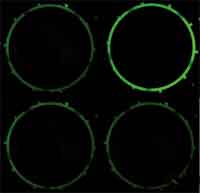 The human body so far is the ultimate 'wet computer' - a highly efficient, biomolecule-based information processor that relies on chemical, optical and electrical signals to operate. Researchers are trying various routes to mimic some of the body's approaches to computing. Especially research related to molecular logic gates is a fast growing and very active area. Already, common logic gates, which are used in conventional silicon circuitry, can be also mimicked at the molecular level. Chemists have reported that a molecular logic gate has the potential for calculation on the nanometer scale, which is unparalleled in silicon-based devices. The general character of the concept of binary logic allows the substitution of electrical signals by chemical and optical signals, which for example opens access to a vast pool of photoactive molecules to be used for the purpose of molecular logic. Molecular logic gate structures using fluorescence changes have been studied intensively using various inputs, such as pH, metal ions, and anions. Now, South Korean scientists using solutions of fluorescent sensor molecules - and, for the first time, proteins - have developed the first soluble molecular logic gates. By using a microfluidic device, input solutions are routed into a central loop, which is filled with a fluorescent sensor solution. There the solutions mix and, in certain combinations, switch the fluorescence 'output' on or off.
The human body so far is the ultimate 'wet computer' - a highly efficient, biomolecule-based information processor that relies on chemical, optical and electrical signals to operate. Researchers are trying various routes to mimic some of the body's approaches to computing. Especially research related to molecular logic gates is a fast growing and very active area. Already, common logic gates, which are used in conventional silicon circuitry, can be also mimicked at the molecular level. Chemists have reported that a molecular logic gate has the potential for calculation on the nanometer scale, which is unparalleled in silicon-based devices. The general character of the concept of binary logic allows the substitution of electrical signals by chemical and optical signals, which for example opens access to a vast pool of photoactive molecules to be used for the purpose of molecular logic. Molecular logic gate structures using fluorescence changes have been studied intensively using various inputs, such as pH, metal ions, and anions. Now, South Korean scientists using solutions of fluorescent sensor molecules - and, for the first time, proteins - have developed the first soluble molecular logic gates. By using a microfluidic device, input solutions are routed into a central loop, which is filled with a fluorescent sensor solution. There the solutions mix and, in certain combinations, switch the fluorescence 'output' on or off.
Dec 5th, 2007
 Shuttles - whether the space shuttle, an airport shuttle bus, or a loom shuttle - basically do one thing: they transport cargo (astronauts, passengers, thread) from one point to another on a controlled route. Although not always called shuttles, the basic concept is critical to modern transportation systems and is used by nearly every society. The concept of the shuttle has been used for centuries from Egyptian barges to Roman railways and canals. Even before these inventions, however, nature employed molecular shuttles in biological organisms. In molecular shuttles, kinesin proteins propel cargo (such as organelles) along hollow tubes called microtubules. Cells use these motors to transport cargo to highly specific destinations, in order to regulate levels of macromolecules and processes, much like a train along a track. Using biological motors to transport and precisely distribute cargo requires a clear understanding of how molecular shuttles pick up and deliver specific payload. However, scientists are challenged by the need to better control the interactions along the route so that the cargo remains on the line when not needed, but when it is needed, can be picked up and transported to a specific location. Researchers in Switzerland have now built nanoscale cargo loading stations and shuttles, an important step towards assembly lines for nanotechnology.
Shuttles - whether the space shuttle, an airport shuttle bus, or a loom shuttle - basically do one thing: they transport cargo (astronauts, passengers, thread) from one point to another on a controlled route. Although not always called shuttles, the basic concept is critical to modern transportation systems and is used by nearly every society. The concept of the shuttle has been used for centuries from Egyptian barges to Roman railways and canals. Even before these inventions, however, nature employed molecular shuttles in biological organisms. In molecular shuttles, kinesin proteins propel cargo (such as organelles) along hollow tubes called microtubules. Cells use these motors to transport cargo to highly specific destinations, in order to regulate levels of macromolecules and processes, much like a train along a track. Using biological motors to transport and precisely distribute cargo requires a clear understanding of how molecular shuttles pick up and deliver specific payload. However, scientists are challenged by the need to better control the interactions along the route so that the cargo remains on the line when not needed, but when it is needed, can be picked up and transported to a specific location. Researchers in Switzerland have now built nanoscale cargo loading stations and shuttles, an important step towards assembly lines for nanotechnology.
Oct 3rd, 2007
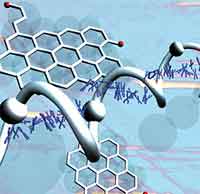 The human body so far is the ultimate 'wet computer' - a highly efficient, biomolecule-based information processor that relies on chemical, optical and electrical signals to operate. Researchers are trying various routes to mimic some of the body's approaches to computing. Prominent among them is DNA computing, a form of computing which uses DNA and molecular biology instead of the traditional silicon-based computer technologies (see our Spotlight: "Molecular automaton plays tic-tac-toe"). Not limited to DNA, "gooware" computer scientists attempt to exploit the computational capabilities of molecules. In doing so, they expect to realize faster (massively parallel), smaller (nanoscale), and cost efficient (energy-saving) information processing devices that are very distinct from today's silicon-based computers.
The human body so far is the ultimate 'wet computer' - a highly efficient, biomolecule-based information processor that relies on chemical, optical and electrical signals to operate. Researchers are trying various routes to mimic some of the body's approaches to computing. Prominent among them is DNA computing, a form of computing which uses DNA and molecular biology instead of the traditional silicon-based computer technologies (see our Spotlight: "Molecular automaton plays tic-tac-toe"). Not limited to DNA, "gooware" computer scientists attempt to exploit the computational capabilities of molecules. In doing so, they expect to realize faster (massively parallel), smaller (nanoscale), and cost efficient (energy-saving) information processing devices that are very distinct from today's silicon-based computers.
May 29th, 2007
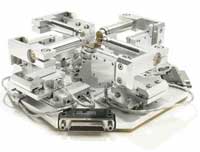 Science fiction style robots like Star Wars' R2-D2 or the NS-5 model in I, Robot firmly belong into the realm of Hollywood - and so do "nanobots" a la Michael Crichton's Prey. Staying with both feet firmly on scientific ground, robotics can be defined as the theory and application of robots, a completely self-contained electronic, electric, or mechanical device, to such activities as manufacturing. Scale that robot down to a few billionth of a meter and you are talking nanotechnology robotics; nanorobotics in short. The field of nanorobotics brings together several disciplines, including nanofabrication processes used for producing nanoscale robots, nanoactuators, nanosensors, and physical modeling at nanoscales. Nanorobotic manipulation technologies, including the assembly of nanometer-sized parts, the manipulation of biological cells or molecules, and the types of robots used to perform these tasks also form a component of nanorobotics. Nanorobotics might one day even lead to the holy grail of nanotechnology where automated and self-contained molecular assemblers not only are capable of building complex molecules but build copies of themselves - "self-replication" - or even complete everyday products (this vision is nicely illustrated in the clip "Productive Nanosystems: From Molecules to Superproducts"). Whether this will ever happen is hotly debated - to understand where both sides stand, read the famous 2003 debate where Drexler and Smalley make the case for and against molecular assemblers. Today's nanorobotics research deals with more mundane issues such as how to build nanoscale motors and simple nanomanipulators.
Science fiction style robots like Star Wars' R2-D2 or the NS-5 model in I, Robot firmly belong into the realm of Hollywood - and so do "nanobots" a la Michael Crichton's Prey. Staying with both feet firmly on scientific ground, robotics can be defined as the theory and application of robots, a completely self-contained electronic, electric, or mechanical device, to such activities as manufacturing. Scale that robot down to a few billionth of a meter and you are talking nanotechnology robotics; nanorobotics in short. The field of nanorobotics brings together several disciplines, including nanofabrication processes used for producing nanoscale robots, nanoactuators, nanosensors, and physical modeling at nanoscales. Nanorobotic manipulation technologies, including the assembly of nanometer-sized parts, the manipulation of biological cells or molecules, and the types of robots used to perform these tasks also form a component of nanorobotics. Nanorobotics might one day even lead to the holy grail of nanotechnology where automated and self-contained molecular assemblers not only are capable of building complex molecules but build copies of themselves - "self-replication" - or even complete everyday products (this vision is nicely illustrated in the clip "Productive Nanosystems: From Molecules to Superproducts"). Whether this will ever happen is hotly debated - to understand where both sides stand, read the famous 2003 debate where Drexler and Smalley make the case for and against molecular assemblers. Today's nanorobotics research deals with more mundane issues such as how to build nanoscale motors and simple nanomanipulators.
Apr 5th, 2007
 The catalytic conversion of chemical to mechanical energy is ubiquitous in biology, powering such important and diverse processes as cell division, skeletal muscle movement, protein synthesis, and transport of cargo within cells. Catalytic 'engines' will be key components of active micron- and sub-micron scale systems for controlled movement, particle assembly, and separations. A few days ago we took a look at catalytic nanomotors - sophisticated molecular-size biomotors have evolved in nature - and described an example where researchers supercharged their nanomotors by inserting carbon nanotubes into the gold and platinum nanowires (Speeding up catalytic nanomotors with carbon nanotubes). Today we show an example where catalytic nanomotors can, in principle, be tethered or coupled to other objects to act as the engines of nanoscale assemblies. Additionally, an object that moves by generating a continuous surface force in a fluid can, in principle, be used to pump the fluid by the same catalytic mechanism. Thus, by immobilizing these nanomotors, a group of scientists have developed micro/nanofluidic pumps that transduce energy catalytically.
The catalytic conversion of chemical to mechanical energy is ubiquitous in biology, powering such important and diverse processes as cell division, skeletal muscle movement, protein synthesis, and transport of cargo within cells. Catalytic 'engines' will be key components of active micron- and sub-micron scale systems for controlled movement, particle assembly, and separations. A few days ago we took a look at catalytic nanomotors - sophisticated molecular-size biomotors have evolved in nature - and described an example where researchers supercharged their nanomotors by inserting carbon nanotubes into the gold and platinum nanowires (Speeding up catalytic nanomotors with carbon nanotubes). Today we show an example where catalytic nanomotors can, in principle, be tethered or coupled to other objects to act as the engines of nanoscale assemblies. Additionally, an object that moves by generating a continuous surface force in a fluid can, in principle, be used to pump the fluid by the same catalytic mechanism. Thus, by immobilizing these nanomotors, a group of scientists have developed micro/nanofluidic pumps that transduce energy catalytically.
 Subscribe to our Nanotechnology Spotlight feed
Subscribe to our Nanotechnology Spotlight feed





